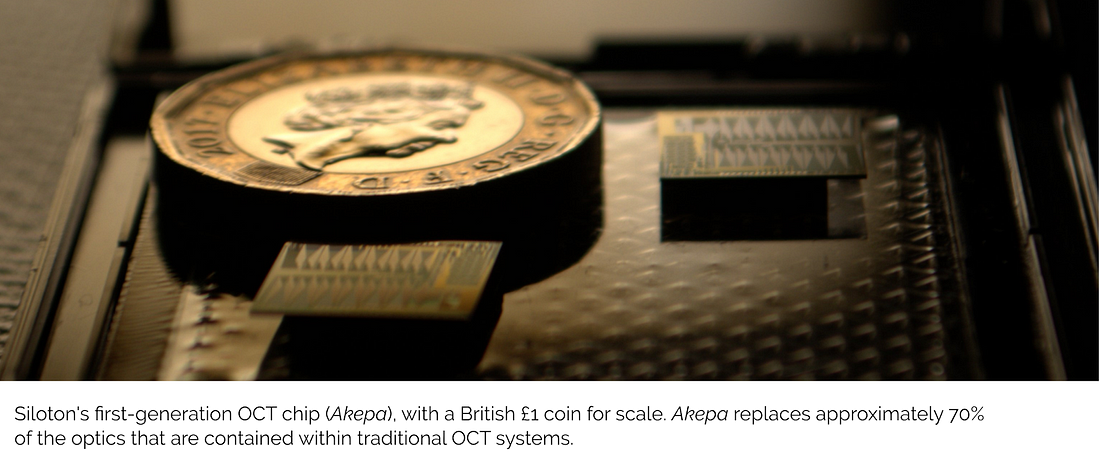Insider Brief:
- Siloton Limited has acquired a sub-surface image of the retina in a synthetic eye, using its revolutionary photonic chip technology.
- The synthetic eye, more commonly known as a retinal phantom, is anatomically analogous to a real eye and is used to calibrate clinical devices.
- The image was taken with Siloton’s first-generation optical coherence tomography (OCT) chip, Akepa.
PRESS RELEASE — BRISTOL, England/March 16, 2023— Siloton Limited, a trailblazing UK start-up, has acquired a sub-surface image of the retina in a synthetic eye, using its revolutionary photonic chip technology. The synthetic eye, more commonly known as a retinal phantom, is anatomically analogous to a real eye and is used to calibrate clinical devices.
The image was taken with Siloton’s first-generation optical coherence tomography (OCT) chip, Akepa. OCT is a non-invasive imaging technique akin to a high-resolution ultrasound, and is the gold standard for diagnosing and monitoring eye disease. At present, it can only be accessed through hospitals and high-end optometrists, because the optical components inside lead to systems that cost tens of thousands of pounds and take up an entire desk. Akepa compresses a tabletop-worth of heavy, expensive and fragile optical components onto a single piece of material smaller than a £1 coin.
As the first OCT image to be taken with Akepa, this already allows for measurements of retinal layer thicknesses. These are a key marker of disease progression in treatable retinal diseases such as wet age-related macular degeneration, retinal vein occlusion and diabetic macular oedema, all of which affect millions of people worldwide.

In reaching this milestone, Siloton cements its position as the world leader in commercial photonic chip OCT, bringing compact and affordable home-monitoring within arms’ reach for some of the most commonly diagnosed conditions in ophthalmology; the busiest outpatient speciality in the NHS.

Cathy Yelf, Chief Executive of national sight loss charity the Macular Society, said:
“We’re delighted to see that Siloton has acquired its first OCT image. We’re excited about this technology, which could make a real difference to people living with macular disease, allowing them to monitor their condition from home. We look forward to continuing to work with the team at Siloton while they continue to develop this technology.”
Dr. Jeff Hogg, Ophthalmology Registrar at NHS Health Education North East, Honorary Research Fellow at Moorfields Eye Hospital NHS Foundation Trust and NIHR Doctoral Fellow at Newcastle University, added:
“This step change in the miniaturisation of OCT can help us to unlock the full value of the progress we already see in ophthalmic telemedicine, workforce mobilisation and patient access.”
Further refinement of the image is ongoing, the results from which will feed into the design of the second-generation Blue Jay chip, as well as Siloton’s wider OCT system.
About Akepa
Akepa is Siloton’s first-generation OCT chip, designed using Redfield, a proprietary, in-house component library. The core circuit comprises over 300 optical and electronic elements, with a further 200 elements integrated alongside this as part of a series of test structures. With approximately 70% of the OCT system on-chip, this is already at the same level of integration as will be required in the final product. Akepa was fabricated in a commercial foundry, providing a clear route to high-volume manufacture at the scales required for widespread monitoring and treatment of retinal disease.
About Siloton
Siloton is developing an at-home monitoring service for the 25% of over 60’s with age-related macular degeneration (AMD), the leading cause of sight loss in the developed world. By combining a personal optical coherence tomography (OCT) system with cloud-based digital health tools, this will create a paradigm shift in the way patients are cared for, ensuring they receive treatment when they need it, not just when they happen to be able to access an OCT in the hospital.
The effects will be threefold. Patient wellbeing will improve, as they will retain their sight for longer, pressure on overstretched outpatient clinics will be alleviated, and the NHS will save half a billion pounds per annum, even if at-home monitoring is only made available to patients with late-stage AMD.
Siloton closed its first investment round in March 2022, raising c. £470k to fund the design, fabrication and testing of Akepa, as well as its integration into a binocular form factor. Siloton’s next round is now open and interested parties are invited to get in touch via [email protected].
To find out more, visit www.siloton.com or follow updates on Siloton’s LinkedIn page.
SOURCE: Siloton
For more market insights, check out our latest quantum computing news here.

















